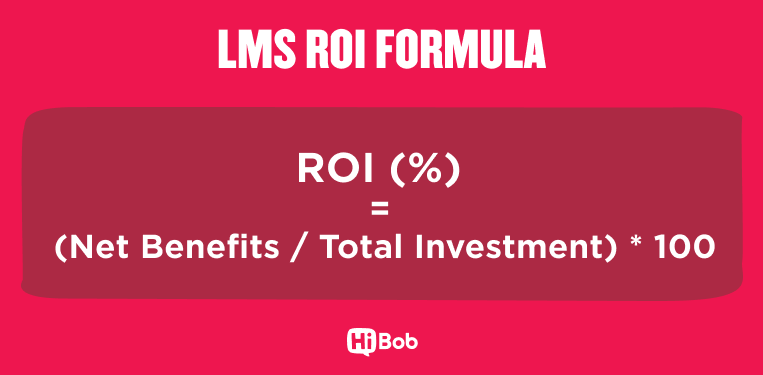HR leaders often turn to learning management systems (LMS) to support their learning and development initiatives. An LMS can help streamline training, track progress, and enhance team member skills.
But, it’s challenging to calculate the return on investment (ROI) of your LMS. Performance improvements take time to manifest and HR teams may find it difficult to measure intangible benefits like employee retention.
To help you tackle the complexity, we’ve developed a guide for calculating and improving your LMS ROI. We’ll review how to assess your learning management system’s financial effectiveness and provide actionable steps to maximize its value.
What is LMS ROI?
LMS ROI measures the financial return from investing in an LMS. It quantifies the benefits an organization gains in comparison to the costs involved in deploying and maintaining the LMS.
Why is LMS ROI important for organizations?
LMS ROI directly impacts an organization’s financial planning. Decision-makers can assess whether the LMS delivers value equal to or greater than its cost.
This insight helps justify the platform’s ongoing expense and can influence decisions regarding upgrades, expansions, or changes in learning strategies.
How to calculate the ROI of your LMS
There are a few different ways to calculate your LMS ROI.
LMS ROI formula
An LMS ROI formula can provide a basic estimate of the financial gains from learning initiatives relative to the investment. Truly assessing the ROI of an LMS involves measuring various metrics that capture qualitative and quantitative benefits.
The simplified formula is:
ROI (%) = (net benefits / total investment) * 100
Net benefits: Net benefits represent the tangible and measurable advantages of using an LMS. These vary depending on an organization’s operations but can include:
- Labor hours saved due to less 1-on-1 training
- Revenue generated from higher productivity
- Cost savings from reduced turnover
Let’s say an LMS helps you reduce the time it takes team members to learn a new skill. You can calculate training cost savings if you know the average hourly wage of the team members and the number of hours saved.
Total investment: This includes the costs incurred from implementing and maintaining the LMS, such as purchase price, implementation fees, and ongoing operational costs.
A positive ROI indicates that the LMS is a worthwhile investment, contributing more in value than it costs to operate.

Metrics for calculating the ROI of your LMS
You can also calculate the LMS ROI by tracking key metrics that reflect the system’s impact. Once you determine these metrics, you can plug them into the formula as net benefits.
User engagement
User engagement metrics help gauge how team members are using the LMS. These metrics include:
- Number of active learners
- Course completion rates
- Average time spent on the platform
- Interaction rates with learning materials
- Frequency of logins
- Perceived value that members get out of their business relationship
High engagement levels can indicate the content is relevant and the platform is user-friendly.
Educational impact
Educational impact metrics measure learning progress and skill acquisition.
Key metrics here include:
- Pre and post-training assessment scores
- Number of certifications earned
- Feedback scores on content relevance
- Training completion rates
- Learning path progression
Operational efficiency
These metrics assess how the LMS contributes to streamlining administrative and training processes.
Look at metrics like:
- Reduction in training time
- Increase in course completion rates
- Administrative time saved through automated features (like scheduling and time tracking)
- Post-training performance improvements
- Decrease in additional support requests beyond initial training
- Reduction in compliance violations
- Increase in time, bandwidth, and productivity due to readily accessible courses
Financial indicators
These metrics measure the cost-effectiveness and revenue of the LMS. Key metrics might include:
- New revenue streams enabled by enhanced training programs
- Decrease in costs associated with high turnover
- Total expense of training per team member
- Savings from reduced in-person training
- Income increase from people who benefit from enhanced training
- Cost-per-employee for LMS maintenance
- Savings from reduced travel
- Savings from a reduction in manual data maintenance
- Revenue generated through strategic initiatives instead of administrative tasks
All of these metrics can impact revenue. If you’re building a business case to demonstrate the value of your LMS investment, tracking these metrics can provide compelling evidence.
How to improve the ROI of your LMS
Follow these steps to improve your LMS ROI:
1. Choose the right LMS
The right LMS can help you optimize your investment in training efforts. Focus on finding a solution that effectively addresses the specific challenges and goals of your company. For example, you may want features to streamline onboarding workflows, improve learner engagement, or access advanced analytics on training effectiveness.
Helpful hint: You can use those analytics to help determine the ROI of your LMS.
2. Integrate with other tools
Enhance your LMS functionality by integrating it with key tools such as your HRIS (Human Resource Information System) or internal communication platforms. Integrating these platforms creates a unified system that streamlines data management and enhances operational efficiency.
This consolidation streamlines access to training within daily workflows and reduces manual tasks. You can gain a full view of team member learning, making it easier to track progress and assess the training’s impact on performance. You can use this information later to calculate the ROI of your LMS.
3. Enhance the user experience
An easy-to-use LMS can lead to higher engagement and more effective learning. Look for an LMS that offers intuitive navigation, mobile accessibility, and personalized learning paths.
4. Improve reporting
Develop comprehensive reporting capabilities to gain deeper insights into training effectiveness, learner progress, and educational outcomes.
HR leaders can use reports to identify the most beneficial and cost-effective training methods. This can lead to a more efficient use of resources, better alignment of training with strategic goals, and, ultimately, a higher ROI.
5. Seek user feedback
Actively seek user feedback to refine and enhance your LMS. This proactive approach ensures the system improves with your team, addresses usability issues, and optimizes the learning experience.
By responding to feedback and making necessary adjustments, you enhance user satisfaction and engagement. This can directly translate into higher ROI as your team becomes more competent and efficient.
<<Start off on the right foot with a successful LMS implementation>>
Benefits of investing in a learning management system
HR leaders can use an LMS to support their organizations with:
Reduced training costs
An LMS significantly cuts training costs with:
- On-demand training access: Team members access training as needed, significantly minimizing downtime
- Automated functions: Leaders can streamline tasks to save time and reduce labor costs with automated progress tracking and report generation
- Reusable content: Teams lowering ongoing content creation costs by updating and reusing training materials without significant new investments
- Remote learning support: HR leaders enable team members across various locations to access training efficiently
Increased scalability
LMS platforms allow HR leaders to efficiently manage training programs for thousands of team members without significant cost increases. This efficiency supports the growth and expansion of training initiatives as the organization evolves.
Improved performance
An LMS enhances performance by offering diverse features that cater to various learning styles. Features such as gamification, real-time assessments, and varied learning modes actively engage team members and support personalized learning experiences.
Together, these elements significantly improve learning outcomes, leading to enhanced individual performance, greater engagement, and increased productivity across the organization.
Enhanced training effectiveness
An LMS can make learning more engaging and effective with interactive assessments and multimedia content. HR leaders can customize learning paths to meet the specific needs of different roles within the organization.
Recommended For Further Reading
Maximize the LMS ROI for your organization
By focusing on these various strategies and metrics to calculate LMS ROI, you can ensure your LMS becomes a valuable asset that supports your organization’s growth and success.
Beyond the numbers, a well-implemented LMS can contribute to employee engagement and retention significantly. When team members feel supported in their learning and development, they’ll want to stay with the company and perform at their best.
Meet Bob
Meet Bob, the modern HR software solution with complete HR functionality. HR leaders can:
- Streamline core HR functions: HR leaders can shift their focus towards more strategic HR initiatives by streamlining typical tedious processes
- Optimize hiring processes: Support growth with efficient applicant tracking systems
- Automate onboarding: Ensure new joiners receive a warm welcome and a seamless start with automated workflows
- Enhance performance management: Enable thorough 360-degree reviews and goal alignment to foster team member growth
- Conduct surveys: Use surveys to gather critical feedback that drives improvement
- Manage time off: Simplify the management of holidays, sick leave, and other leave types
- Simplify payroll operations: Reduce preparation time and ensure accuracy by integrating payroll management within your HR system


